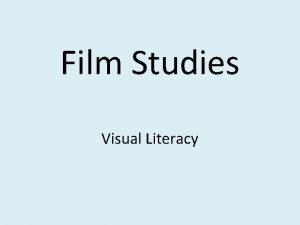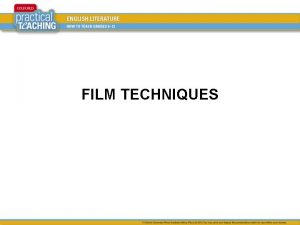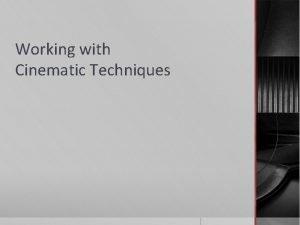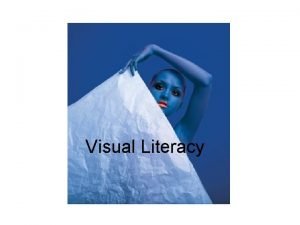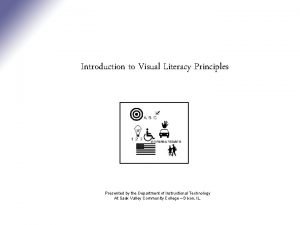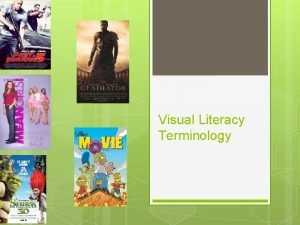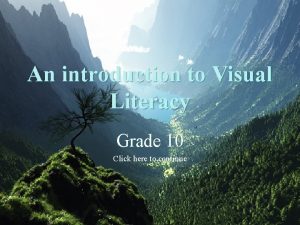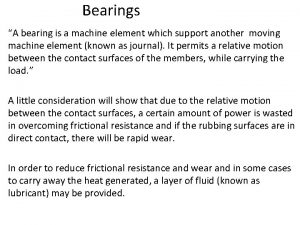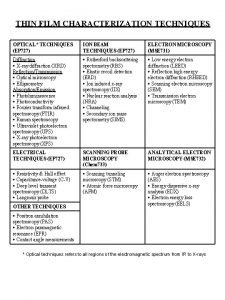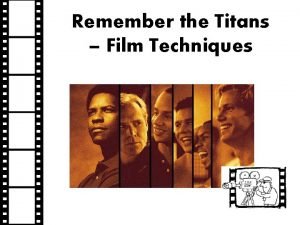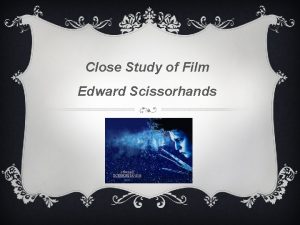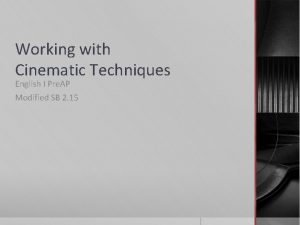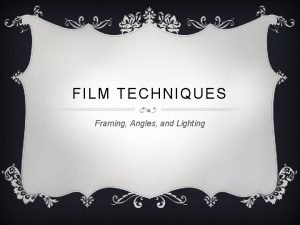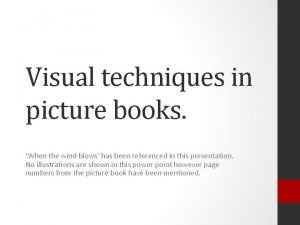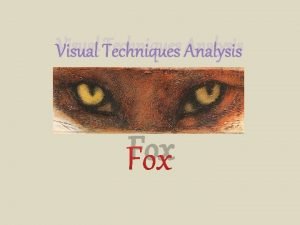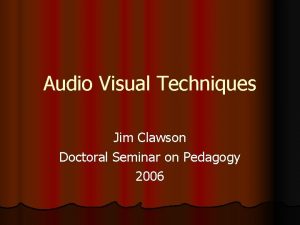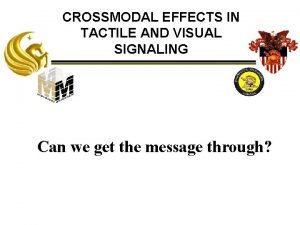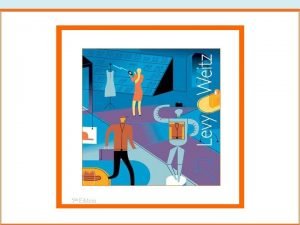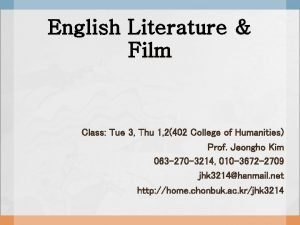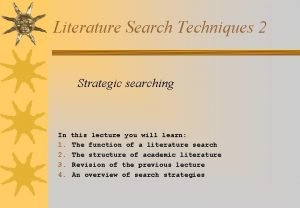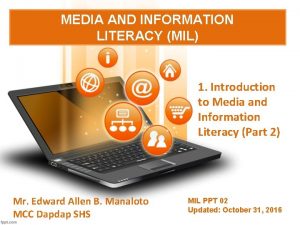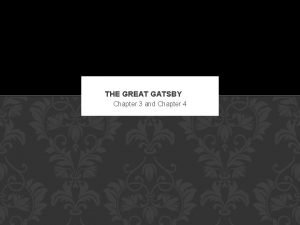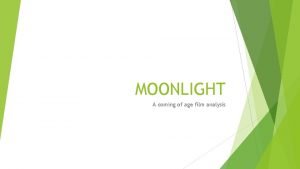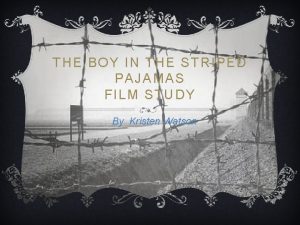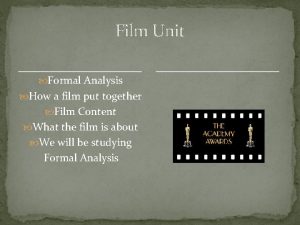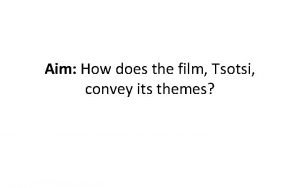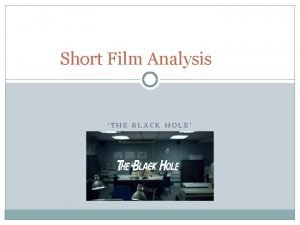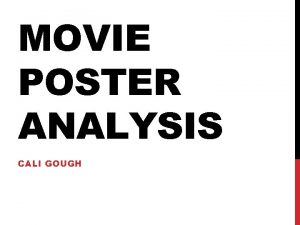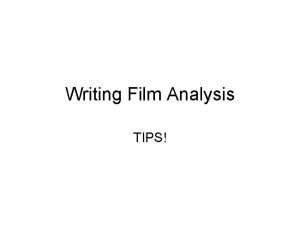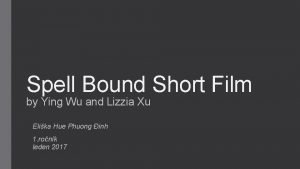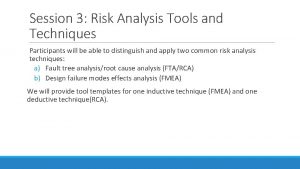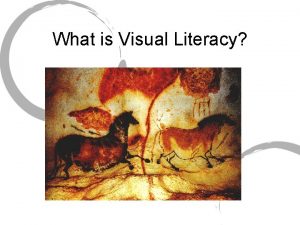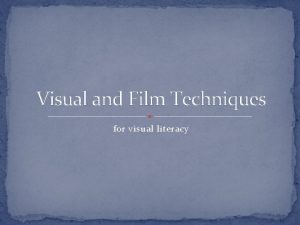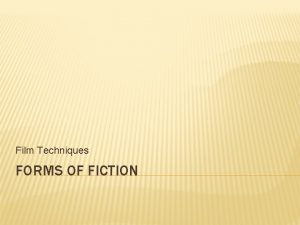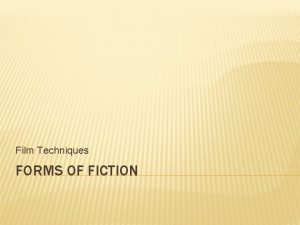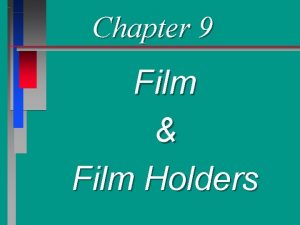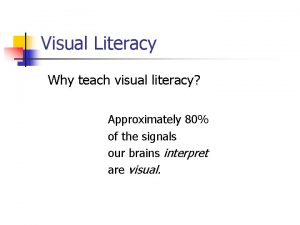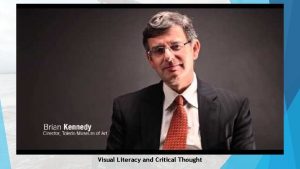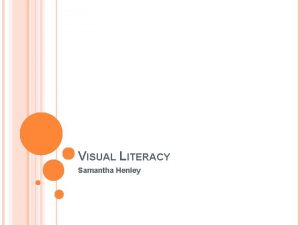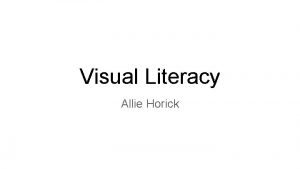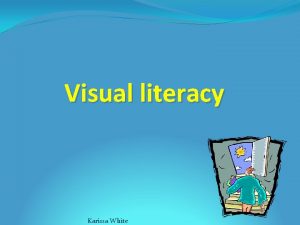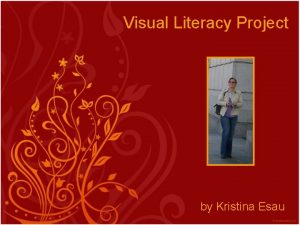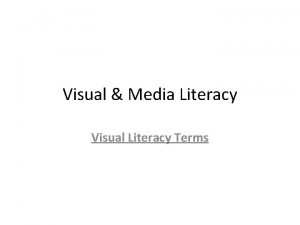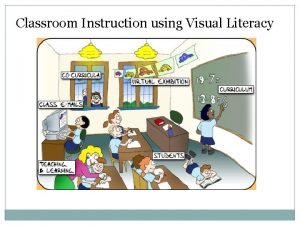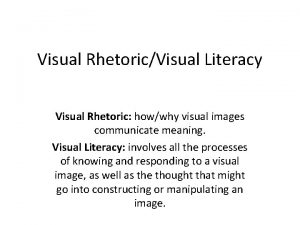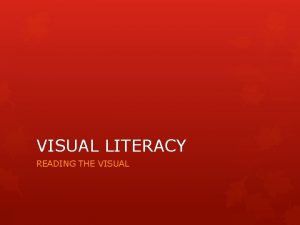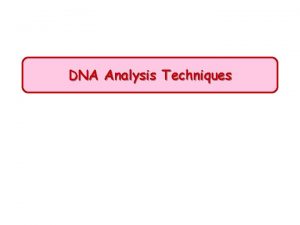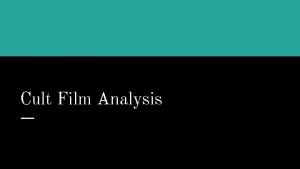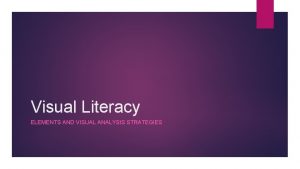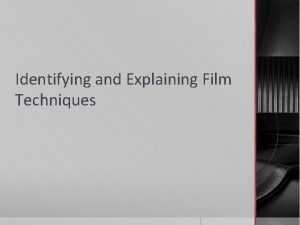Film Techniques Visual Literacy Film As Literature Analysis











































- Slides: 43

Film Techniques Visual Literacy & Film As Literature Analysis of Motion Pictures

Camera Angles • To create different effects, a director must take into account where the camera will be placed in relation to the object being shot. • Three main types: – Low angle – High angle – Eye level angle

Low Angle • Camera shoots subject from below; has the effect of making the subject look larger than normal; strong, powerful, or threatening

Low Angle

High Angle • Camera is above the subject; usually has the effect of making the subject look smaller than normal, weak, powerless, or trapped

High Angle

Eye-level Angle • Accounts for 90 -95% of the shots seen because it’s the most natural; camera is even with the key character’s eyes

Eye-level Angle

Camera Movement • Directors and camera operators have developed ways for cameras to help tell the story on the big screen, primarily in the way the camera moves. • Types of camera movement: – Pan – Tilt – Dolly – Zoom

Pan • Stationary camera move either left or right (like shaking your head)

Tilt • Stationary camera moves either up or down (like nodding your head)

Dolly • The camera itself is moving with the action on a track with wheels or held by hand

Camera Movement

Zoom • The camera is stationary, but the lens moves, making the objects appear to grow larger or smaller

Zoom

Lighting • Lighting can play an essential role in creating particular effects desired by the director • The principle source of light on a set is called the “key light. ” • Other light sources are used to balance, soften, and shade the key light. • Types: low key, high key, neutral

Low-key Lighting • Scene is flooded with shadows and darkness; creates suspense/suspicion or the possibility for romance • Could indicate: evil, fright, intensity, obscurity

Low Key Lighting

High-key Lighting • scene is flooded with light; creates a bright and open-looking scene. • Could indicate: innocence, beauty, bravery, benevolence

High Key Lighting

Neutral Lighting • Neither bright nor dark; even lighting throughout the shot

Neutral Lighting

Sound • Sound is a crucial, though often overlooked aspect of film • Directors use sound in many ways to create desired effects. • Sound could be: dialogue, music, sound effects, etc. • Two main types: diegetic and nondiegetic

Diegetic Sound • Sound that could be heard logically by the characters in the film. Can be internal diagetic, meaning that the sound can be heard only within the mind of one character

Nondiegetic Sound • Sound that can not be heard by any characters; sound given directly to the audience by the director

Focus • The director uses focus techniques to communicate things to the audience. • Some types are: – Soft focus – Rack focus – Deep focus

Soft Focus • When the director intentionally puts his or her object slightly out of focus to make the image look softer or unclear.

Soft Focus Shot

Rack Focus • When the director shifts the focus from one object to another in the same shot in order to direct the audience’s attention.

Rack Focus

Deep Focus • When the foreground and background are equally in focus.

Deep Focus

Editing • Editing describes how shots are put together, or how a director chooses to move from one shot to another. • Types of shot editing: – – – Cut Fade Dissolve Crosscutting Flashback Eye-line match

Cut • “CUT TO” • An individual strip of film consisting of a single shot; the separation of two pieces of action as a "transition" (used when one says "cut from the shot of the boy to the shot of the girl"); a verb meaning to join shots together in the editing process; or an order to end a take ("cut!").

Fade • “FADE IN” or “FADE OUT” • Scene fades to black or white; often implies that time has passed

Dissolve • An image fades into another; can create a connection between images

Dissolve

Crosscutting • Cut to action that is happening simultaneously; also called parallel editing • Can appear as two shots side by side, OR, more commonly, alternating frequently between two scenarios about the collide…

Crosscutting

Flashback • Movement into action that has happened previously • Often signified by a change in music, voice-over narration, or a dissolve • A flash-forward leads us ahead in time

Flashback

Eye-line Match • A shot of a person looking, then a cut to what he or she saw, followed by a cut back for a reaction

Eye-line Match
 Visual literacy in film
Visual literacy in film Visual techniques in film
Visual techniques in film Film analysis techniques
Film analysis techniques Venn diagram media information and technology literacy
Venn diagram media information and technology literacy M.i.l subject
M.i.l subject People in media vs people as media examples
People in media vs people as media examples Cyber literacy and digital literacy
Cyber literacy and digital literacy Gaze visual technique
Gaze visual technique Principles of visual literacy
Principles of visual literacy Visual literacy terminology
Visual literacy terminology Visual literacy children's picture books
Visual literacy children's picture books Visual literacy grade 10
Visual literacy grade 10 Wedge film journal bearing
Wedge film journal bearing Thin film characterization techniques
Thin film characterization techniques Remember the titans film techniques
Remember the titans film techniques Lion film techniques
Lion film techniques Edward scissorhands film techniques
Edward scissorhands film techniques Film techniques english
Film techniques english Framing techniques in film
Framing techniques in film Les fonctions techniques et les solutions techniques
Les fonctions techniques et les solutions techniques Examples of visual techniques
Examples of visual techniques Vector visual technique
Vector visual technique Audio visual techniques
Audio visual techniques Use visual signaling techniques
Use visual signaling techniques Objectives of good store design ppt
Objectives of good store design ppt Apakah maksud visual pada kata pemrograman visual?
Apakah maksud visual pada kata pemrograman visual? Literature and film class
Literature and film class Techniques in literature
Techniques in literature Search strategy google scholar
Search strategy google scholar Gothic metaphors and similes
Gothic metaphors and similes Tobias wolff say yes
Tobias wolff say yes Media information literacy poster
Media information literacy poster Chapter 4 gatsby summary
Chapter 4 gatsby summary Ilearn nwrc
Ilearn nwrc Film the boy in the striped pyjamas
Film the boy in the striped pyjamas Side lighting in film
Side lighting in film Formal elements of film
Formal elements of film Tsotsi film themes
Tsotsi film themes The black hole short film analysis
The black hole short film analysis Moonlight movie poster analysis
Moonlight movie poster analysis How to write a film analysis
How to write a film analysis Spell bound film
Spell bound film Fact finding techniques in sad
Fact finding techniques in sad Risk analysis tools and techniques
Risk analysis tools and techniques
